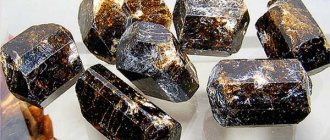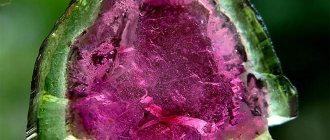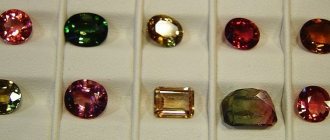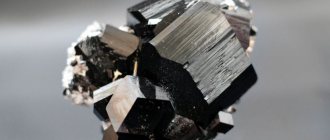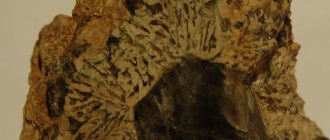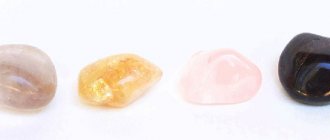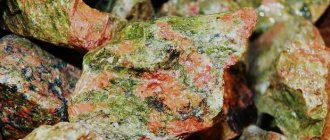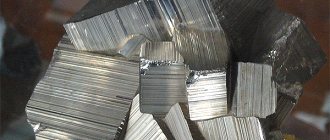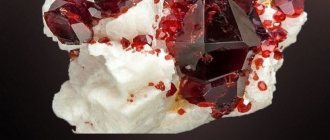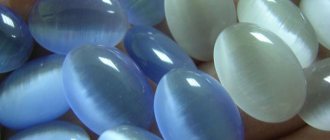Garnet is not a single gemstone, but is a group of several closely related minerals. All types of garnets have similar physical properties and crystal forms, but differ in chemical composition.
Garnets are non-silicates with the general formula X3Y2(SiO4)3. The X field is usually occupied by divalent cations (Ca, Mg, Fe, Mn)2+, and the Y field by trivalent cations (Al, Fe, Cr)3+ in an octahedral/tetrahedral structure with [SiO4]4. Garnets are most often found in the shape of a dodecahedron, but also in the shape of a trapezoid.
Because the chemical composition of garnet varies, the atomic bonds in some varieties are stronger than others. As a result, this group of minerals has a Mohs hardness range of approximately 6.5 to 7.5.
Chemical composition
Depending on whether the Y or X component is constant in the chemical composition of a species, we can divide the members of the garnet family into two groups:
- Pyralspites (pyrope, almandine, spessartite) with aluminum in the Y position.
- Ugrandites (uvarovite, grossular, andradite) with calcium in the X position.
Each member of these two groups has an "ideal" chemical composition:
- Pyrope (magnesium aluminum silicate).
- Almandine (iron and aluminum silicate).
- Spessartite (manganese aluminum silicate).
- Uvarovite (calcium and chromium silicate).
- Grossular (calcium aluminum silicate).
- Andradite (calcium iron silicate).
In the above list of pyralspites, the first element mentioned varies from member to member. However, in nature you will never find pyrope with such a pure chemical composition. Instead, other elements present in the melt from which the pyrope grew are mixed in during growth.
When iron (as shown in the almandine above) is mixed in during the growth of pyrope garnet, the result is a magnesium iron aluminum silicate. Part of the magnesium in pyrope is replaced by iron.
It is the amount of magnesium/iron that determines the difference between pyrope and almandine. When a large amount of magnesium is present in a chemical composition, it is pyrope. When iron predominates, it is almandine.
When the mixture is somewhere in the middle, we call it pyrope-almandine (such mixtures may have some exotic names, such as rhodolite, but that doesn't matter here). It should be noted that the boundaries of where it is pyrope and where it is almandine are the subject of serious debate.
What is
Borax is a mineral, sodium borate with a hydroxyl group:
- It looks like a conglomerate of weakly colored, slightly transparent crystals or the same powder.
- When exposed to light, the crystals are colorless.
- It is not always a brown mineral. More often it is white with a grayish, yellowish color. Rare - samples with a greenish or bluish tint.
- Borax has a matte resinous sheen.
Residents of Asia call the mineral tinkar or tincal. For Russians and residents of the post-Soviet space, this is boric acid, borax.
In pharmacies and hardware stores, borax is sold as a white powder.
Group of pomegranates
Almandine
Almandine crystal with muscovite crystals on the side. Gilgit District, Northern Areas of Pakistan
Almandine is the most common garnet. Almandine crystal formula: Fe3Al2(SiO4)3. Magnesium can replace iron, which shifts the composition of the mineral closer to pyrope. The color of almandine varies from dark red to black. It is often cut into a convex facet or cabochon, and is then known as a carbuncle.
Pyrope
Raw pyrope
Pyrope is the only member of the garnet family that is always red in natural specimens. Pyrope is particularly noted for its clarity and frequent absence of blemishes and inclusions. The composition of pure pyrope is Mg3Fe2(SiO4)3, although usually other elements (Ca, Cr, Fe and Mn) are present, at least in minor quantities. The origin of most pyrope is in ultramafic rocks, usually peridotites from the Earth's mantle. These mantle peridotites can be attributed to both igneous and metamorphic processes.
Varieties of pyrope:
- Rhodolite is a purple variety of pyrope-almandine. The name and color come from the rhododendron flower. It is often considered a type of pyrope.
- Malaya is a red-orange variety of pyrope-spessartine discovered in the 1970s in Kenya as a by-product of rhodolite.
Spessartine
Spessartine of various cuts
Spessartine is an orange to red colored gemstone. Spessartine is a non-silicate manganese-aluminum garnet Mn²⁺₃Al₂ (SiO₄)3. It is most commonly found in granitic pegmatite and related rock types, as well as some low-grade metamorphic phyllites. Spessartine, like other garnets, is always mixed with other types. Gemstones with a high spessartine content tend to have a light orange hue, while a predominance of almandine causes red or brownish hues.
Andradite
Demantoid-andradite on the matrix
Andradite is an iron-calcium garnet, Ca3Fe2(SiO4)3, which has a variable composition and can be red, yellow, brown, green or black. Andradite is the most brilliant of all garnets and comes in several varieties.
Andradite comes in three varieties:
- Melanite: shiny, opaque, black or very dark red; another name is titanium andradite.
- Demantoid: olive green to emerald green; one of the most valuable and rare stones in the gemological world.
- Topazolite: yellow to brownish-yellow; sometimes of sufficient quality that it can be cut into a gemstone; is less common than demantoid.
Andradite occurs in skarns formed in contact metamorphosed contaminated limestones or calcareous igneous rocks; in chlorite schists and serpentinites, as well as in alkaline igneous rocks (usually titanium-bearing).
Grossular
Grossular is the most colorful of the garnets. It has the chemical formula Ca3Al2(SiO4)3, but calcium can be partially replaced by ferrous iron and aluminum by ferric iron. Pure grossular is colorless. The wide range of colors of this garnet is caused by various impurities. Some types of grossular have their own unique varieties or trade names in the gemstone market. The most famous are orange-brown hessonite and dark green tsavorite.
Hydrogrossular from the Jeffrey Mine Asbestos, Quebec, Canada
Varieties of grossular:
- Hessonite is a transparent variety of grossular that is orange to orange-brown in color.
- Hydrogrossular is a variety of grossular that is green, pink, grayish-white, bluish in color.
Tsavorites on a graphite matrix from the Merelani Mine, Arusha, Tanzania
Chrome grossular is a green variety of grossular.
- Tsavorite (or tsavolite) is a grossular that, like the mint green Merelani garnet, is green in color. Chrome and/or vanadium painted. It is generally believed that the difference between "regular" green grossular and tsavorite depends on saturation and tone. However, according to Campbell Bridges, the difference is chemical in nature. The chromophore of green grossular is iron, as opposed to chromium and/or vanadium.
- Mali is a yellow-green variety of grossular with a slight overlap of a number of andradite grossulars.
Uvarovite
Magnificent crystals of green uvarovite on a chromite matrix from the Urals, Russia
Uvarovite is the rarest garnet known and is rarely used as a gemstone. This is a calcium-chromium garnet with the formula Ca3Cr2(SiO4)3. The color of uvarovite is deep chrome green. This is a unique garnet that comes in only one color.
Where is it used?
The mineral is popular in industry and everyday life. Its main mission is to be a source for obtaining boron.
Industry
Borax is used in various industries:
- Production of paper, glass, glaze, enamel.
- Component of technical fluids for mechanical engineering and the automotive industry.
- Disinfectant, preservative.
- Flux for soldering metals.
- Impregnation of textiles and ecowool cellulose insulation before painting.
Chemists use borax as a marker of the composition of metal oxides and the concentration of acid solutions.
Household sphere
The mineral powder has found application as a home sanitation product:
- Mold removal. Wet borax is applied to problem areas overnight. Wash off in the morning.
- Removing rust, scale, lime layer. A glass of powder is poured into the toilet, sink overnight, and cleaned in the morning.
- Bleaching. Before washing, add borax and baking soda (2.5-3 tsp each) to a container of water.
- Cleaning. Borax is dissolved with water (100 ml dessert spoon). Store in a tightly closed container, add to water when washing windows and floors.
- Removing gaps in pipes. A mixture of borax powder, soda (half and half), 200 g of vinegar (9%) and a liter of boiling water is poured into the pipe overnight.
- Aromatization. To get rid of mustiness and unpleasant odors, wipe the oven, refrigerator, and freezer with a borax solution.
Cockroaches and other insects are exterminated with “bait” from the yolk of a hard-boiled egg with boric acid.
Pure borax is scattered on the beds and along the baseboards to get rid of rodents.
Medicine, cosmetology
- The most popular pharmaceutical preparation from the mineral is boric acid.
- To treat fungus, doctors prescribe brown-glycerin preparations to patients.
- Borax is used in the production of shower gels, shampoos, and ointments.
- The non-food segment is in demand for a mineral obtained artificially.
The popularity of preparations made from the mineral is due to its affordable price.
The cost of a bottle of sodium tetraborate (30 ml) in pharmacies is 19-48 rubles, a kilogram of cockroach repellent is 250-300 rubles.
Interesting properties of the mineral
Tourmaline is a unique natural stone. It has its own charge and electrical radiation, very similar to that of the human body. The gem is charged with energy from the Sun, and then releases it to the outside world.
Thus, infrared rays emanate from the stone, which are beneficial for our cells. When crushed, the mineral has a warming effect. It is also used to ionize air, which is especially useful after illness or surgery.
Interesting: red and colorless types of tourmaline have luminescence, that is, they can glow on their own in the dark. True, their glow is weak.
Tourmaline has the ability to neutralize electromagnetic waves from microwave ovens, TVs and other equipment. I advise you to place such a stone near the device to protect yourself.
The healing power of tourmaline
The beneficial properties of the mineral are used not only by lithotherapists who treat with stones, but also by ordinary doctors. It is an integral part of some medical devices, air ionizers, as well as products such as belts, mats and even socks. Crystals are sewn into the material, and they have a local effect, helping to recover faster from injuries, illnesses, and operations.
The energy emanating from the crystal saturates our cells with oxygen.
Greens rejuvenate the body. People wearing a product with this stone have a fresher appearance. It also stimulates the nervous system. By the way, this is the only tourmaline that directly promotes weight loss. It is also useful for the cardiovascular system.
Blue stone restores order in the body. It affects the nervous system, relieves stress and psychological problems. Indicolites affect hormonal levels and normalize metabolic processes.
Blues tend to improve reproductive function in both men and women.
Red minerals can improve blood counts. Lithotherapists use it to eliminate problems in the genitourinary system.
Yellow stones are associated with the gastrointestinal tract, particularly the gallbladder and liver. They also have calming properties and relieve anxiety.
Black is a protector against colds and viruses. It helps with infectious diseases.
Important: it is not recommended to use the gem at high temperatures, as the energy of the stone can increase it even more.
For wounds and injuries, use a bandage with tourmaline of any color or simply apply it to the sore spot. This is done 2 days after the damage.
How to store and use
Borax is classified as class 4 chemically hazardous elements:
- You need to use it while wearing gloves.
- Store in a tightly sealed container.
- Place the container in a dry, dark place.
- Avoid contact of the substance with the skin and mucous membranes. If this happens, immediately wash the area with clean water.
Before using the drug, carefully read the instructions. Especially the section regarding security measures.
Borax as a collection material requires the same precautions. Plus one more thing: crystals are fragile, they are stored in a closed box . Dust is brushed off with a soft brush.
Choice by zodiac sign
Who is suitable for pomegranate according to the horoscope? According to astrologers, this stone is ideal for energetic and tireless Capricorns. The mineral also favors Leo and Sagittarius. Representatives of these zodiac signs can wear stones of any shade. But when choosing a garnet, Aquarius and Libra should give preference to green stones. Pisces and Cancers should completely abandon the use of the mineral as an amulet. For people born under these signs, it will deprive them of peace and lead to physical fatigue.
Gold jewelry SL with cognac diamonds, garnet (go to the SUNLIGHT catalog)
In order for a garnet to fully exhibit its magical properties, it is necessary to choose a stone as an amulet that has not previously had an owner. Such a mineral has powerful energy and will become a reliable amulet for its owner. If a person inherited jewelry with a gem, it must be cleaned by holding it under running cold water for several minutes. After the procedure is completed, the product can be worn without fear. From this moment on, his energy will work in favor of his new owner.
